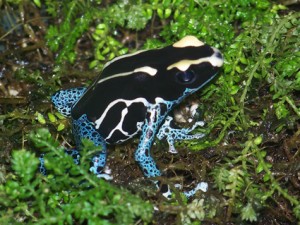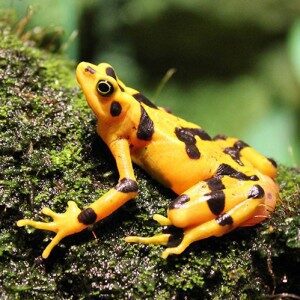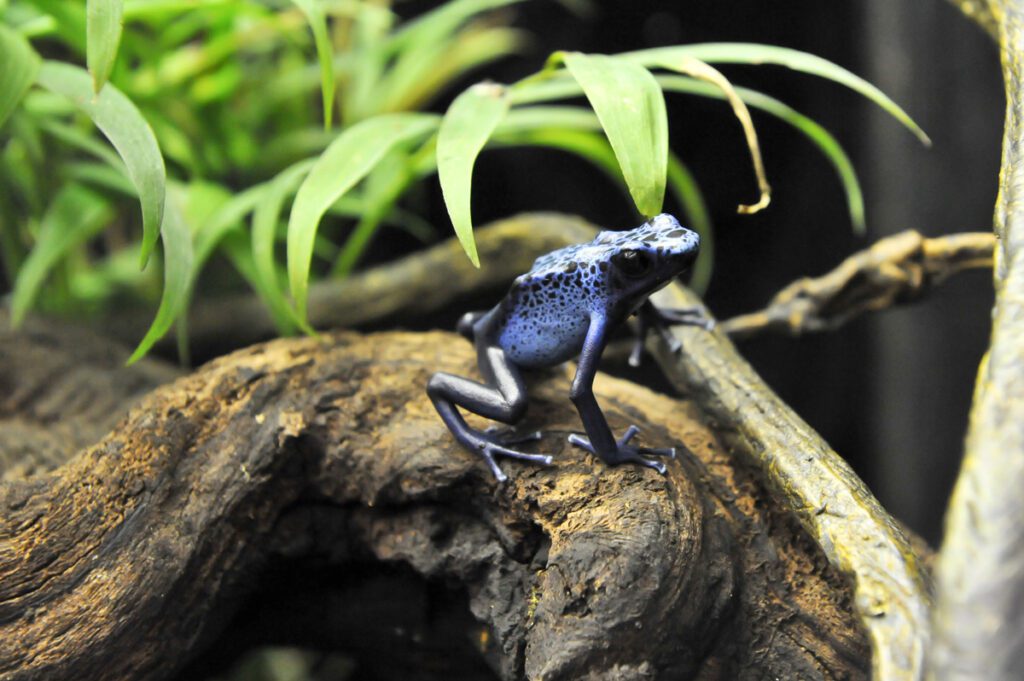

You may have walked right past the frog room in the Main Building during your last visit, but Hannah Comstock, one of the zoo keepers who keeps this area of the Zoo running, thinks it’s worth a second look. We talked with her about what she loves about working with frogs, and what makes them so special.Where is the frog room at the Zoo? How many and what types of species are housed there?
The frog room is located in the Main Building near the Aviary. We have three habitats with multiple species of frogs: Panamanian Golden Frogs (Atelopus zeteki) and Green and Black Poison Dart Frogs (Dendrobates auratus) located in the hallway near the snakes and the Rotunda with the Pied Tamarins; Nominate Dyeing Poison Dart Frogs, Green Dyeing Poison Dart Frogs (Dendrobates Tinctorius), and Yellow-banded Poison Dart Frogs (Dendrobates leucornelas) in the entry way to the Aviary; and Vietnamese Mossy Frogs (Theloderma corticale) in another tank.
What is the most important duty of yours as a keeper in this area of the Zoo?
Maintaining the tanks is a big part of my job in the frog room. When I work there, I make sure to mist every tank daily. Some tanks also have fog machines that I turn out periodically throughout the day. I remove dead leaves, clean off plants of any waste, and once a week every tank gets a complete water change. We don’t use plain tap water for the tanks; we have a special filtration system to make the water habitable for the frogs. Occasionally, we will hear the frogs calling and see them enter amplexus, which is how they mate. At this point, I make sure to keep an eye out for any eggs or tadpoles so we can pull them out and raise them separately from the adults. We also breed fruit flies to feed them, which is a big part of working in the frog room. Making sure we have enough food for them and making new fly cultures is a weekly task.


What was your training and experience before becoming a zoo keeper?
I have a very long history with Seneca Park Zoo. When I was younger, I was a camper here at the Zoo. Soon after that, I was part of a program called Zoo Explorers where we learned more about what it takes to be a zoo keeper. After that, I decided to join the ZooTeen program and participated in that for four years. I went to college at SUNY- ESF, or College of Environmental Science and Forestry, where I received a bachelor’s degree in conservation biology. While attending college, I had an internship with the Rosamond Gifford Zoo in Syracuse, where I worked two days a week with their seven Asian Elephants. I continued to volunteer with Seneca Park Zoo staff for a year after graduating, before being hired as a zoo keeper.


What is the first thing you do each day to care for the species in the frog room? The last thing each day?
The first thing I do every day is make sure everyone is accounted for and doing well. Next, I make sure the tanks are clean and everyone gets a good misting. The last thing I do is feed every frog and make sure the tanks are securely closed before heading home.
What is one thing someone can do individually to help save frogs in their natural range or provide a better environment for them?
One thing we all can do is reduce, reuse, and recycle! Buying items with less packaging and buying items we can use over and over again is a great way to cut down on waste, but on the occasions when it can’t be avoided, try buying something recyclable so it doesn’t end up in a landfill. Keeping our environment healthy and our waterways clear will help amphibian species survive better alongside us.
What is something about frogs that most people probably don’t know?
Poison dart frogs derive their toxins from the food that they eat in their natural range. This is different from poisonous toads, which have something called a parotid gland behind their eye that secretes the toxins that they produce themselves. Amphibians in general also have very sensitive skin that is permeable to water. If you ever come to the Zoo and see a keeper wearing rubber gloves while handling the frogs or while they are cleaning, it is to protect the frogs from anything we may have on our hands.


What has been the most surprising thing you’ve learned about frogs?
Despite their size, they all have such personalities! We have some that will always hide from you when you open the tank and some that will sit there without any problem. Some climb walls, some swim, some are easy to catch, and some are extremely difficult. To a guest, they may all look exactly the same, but to me they are all unique. I can tell them apart from the spots on their back or the way the lines on their legs are shaped. Spend enough time with the frogs at the Zoo, and you will see they are all individuals and all very special creatures.Hannah Comstock, Zoo Keeper








